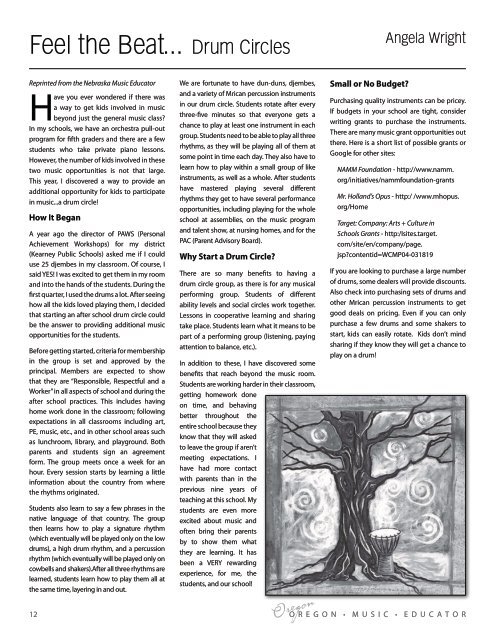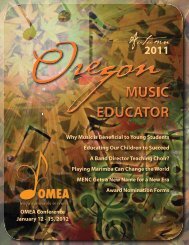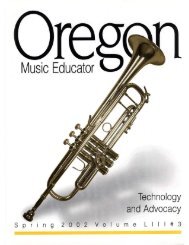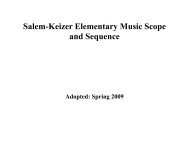OMEA Spring 2013 web.pdf - Oregon Music Education Association
OMEA Spring 2013 web.pdf - Oregon Music Education Association
OMEA Spring 2013 web.pdf - Oregon Music Education Association
You also want an ePaper? Increase the reach of your titles
YUMPU automatically turns print PDFs into web optimized ePapers that Google loves.
Feel the Beat... Drum CirclesAngela WrightReprinted from the Nebraska <strong>Music</strong> EducatorHave you ever wondered if there wasa way to get kids involved in musicbeyond just the general music class?In my schools, we have an orchestra pull-outprogram for fifth graders and there are a fewstudents who take private piano lessons.However, the number of kids involved in thesetwo music opportunities is not that large.This year, I discovered a way to provide anadditional opportunity for kids to participatein music...a drum circle!How It BeganA year ago the director of PAWS (PersonalAchievement Workshops) for my district(Kearney Public Schools) asked me if I coulduse 25 djembes in my classroom. Of course, Isaid YES! I was excited to get them in my roomand into the hands of the students. During thefirst quarter, I used the drums a lot. After seeinghow all the kids loved playing them, I decidedthat starting an after school drum circle couldbe the answer to providing additional musicopportunities for the students.Before getting started, criteria for membershipin the group is set and approved by theprincipal. Members are expected to showthat they are “Responsible, Respectful and aWorker” in all aspects of school and during theafter school practices. This includes havinghome work done in the classroom; followingexpectations in all classrooms including art,PE, music, etc., and in other school areas suchas lunchroom, library, and playground. Bothparents and students sign an agreementform. The group meets once a week for anhour. Every session starts by learning a littleinformation about the country from wherethe rhythms originated.Students also learn to say a few phrases in thenative language of that country. The groupthen learns how to play a signature rhythm(which eventually will be played only on the lowdrums), a high drum rhythm, and a percussionrhythm (which eventually will be played only oncowbells and shakers).After all three rhythms arelearned, students learn how to play them all atthe same time, layering in and out.We are fortunate to have dun-duns, djembes,and a variety of Mrican percussion instrumentsin our drum circle. Students rotate after everythree-five minutes so that everyone gets achance to play at least one instrument in eachgroup. Students need to be able to play all threerhythms, as they will be playing all of them atsome point in time each day. They also have tolearn how to play within a small group of likeinstruments, as well as a whole. After studentshave mastered playing several differentrhythms they get to have several performanceopportunities, including playing for the wholeschool at assemblies, on the music programand talent show, at nursing homes, and for thePAC (Parent Advisory Board).Why Start a Drum Circle?There are so many benefits to having adrum circle group, as there is for any musicalperforming group. Students of differentability levels and social circles work together.Lessons in cooperative learning and sharingtake place. Students learn what it means to bepart of a performing group (listening, payingattention to balance, etc.).In addition to these, I have discovered somebenefits that reach beyond the music room.Students are working harder in their classroom,getting homework doneon time, and behavingbetter throughout theentire school because theyknow that they will askedto leave the group if aren’tmeeting expectations. Ihave had more contactwith parents than in theprevious nine years ofteaching at this school. Mystudents are even moreexcited about music andoften bring their parentsby to show them whatthey are learning. It hasbeen a VERY rewardingexperience, for me, thestudents, and our school!<strong>Oregon</strong>Small or No Budget?Purchasing quality instruments can be pricey.If budgets in your school are tight, considerwriting grants to purchase the instruments.There are many music grant opportunities outthere. Here is a short list of possible grants orGoogle for other sites:NAMM Foundation - http://www.namm.org/initiatives/namm foundation-grantsMr. Holland’s Opus - http:/ /www.mhopus.org/HomeTarget: Company: Arts + Culture inSchools Grants - http:/Isites.target.com/site/en/company/page.jsp?contentid=WCMP04-031819If you are looking to purchase a large numberof drums, some dealers will provide discounts.Also check into purchasing sets of drums andother Mrican percussion instruments to getgood deals on pricing. Even if you can onlypurchase a few drums and some shakers tostart, kids can easily rotate. Kids don’t mindsharing if they know they will get a chance toplay on a drum!12 O R E G O N ∙ M U S I C ∙ E D U C A T O R






